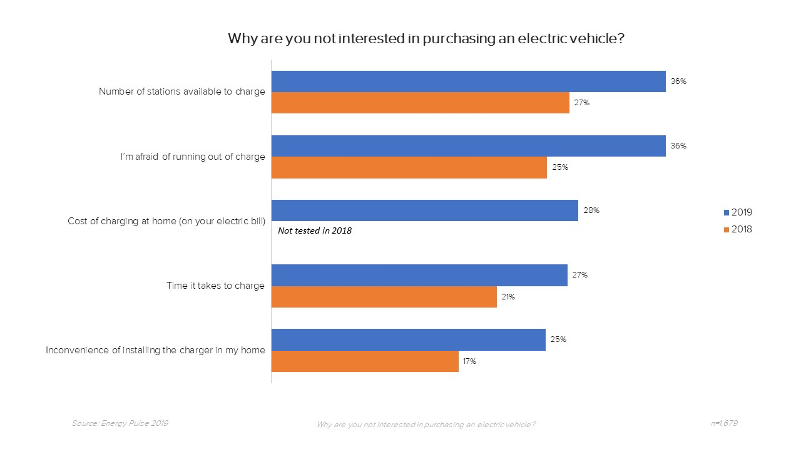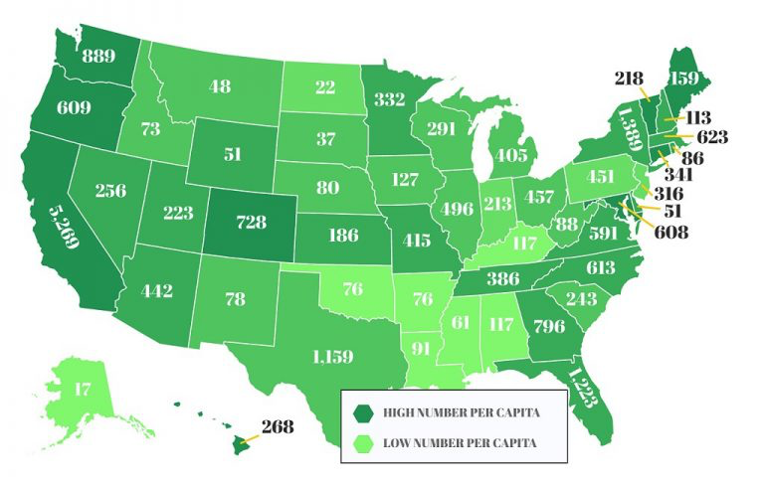Where do I charge this thing?
Shelton Stat of the Week
5 out of Americans’ top 7 barriers to EV ownership are related to concerns about charging.
Where do I charge this thing?
The number of EVs is quickly overwhelming the current charging infrastructure, so what now?
Sixty-five percent of Americans believe climate change is happening and that it’s caused by human activity, and they’re most likely to believe it’s the cars they drive that are contributing to the problem. That means it’s a no-brainer that most of us consider electric vehicles the best solution for improving an individual’s impact on global warming. At Shelton Group, we’ve just completed our second annual look at consumer beliefs and expectations around EVs, and you can get your free copy of that report here. This is the first of two reports that will hit the highlights and reveal some of the market opportunities revealed in the data.
Right now, about 5% of us drive EVs or plug-in hybrids, but get this: almost half of us are already adopting behaviors that reduce our emissions from driving. From using Uber to taking buses and bikes to work, most of us are thinking in terms of using less gas in our daily lives. That also explains why interest in buying an EV rose dramatically from 8% in 2018 to 13% in 2019. Doing better for the environment is the #1 reason people currently own EVs, as well as the #1 reason the other 13% are considering owning one. The desire to reduce emissions from the cars we drive is clearly there, and even though cost is currently the biggest barrier to buying an EV, falling prices (due to cheaper batteries, more models and economies of scale) will likely reduce that obstacle more and more in the coming years. So what will hold us back? It’s simple: infrastructure. As Green Car Reports puts it:
“As electric car sales begin climbing, so do stories of long waits at public chargers, pointing out the need for the number of electric cars not to overwhelm the available infrastructure. This problem will only increase as more city and apartment dwellers begin buying electric cars.”
Consider this: in 2018, 12% of EV owners had an electric vehicle charging station installed in their homes. In 2019, that number jumped to 44%! Interest in having a charging station at home also grew among those who are considering purchasing an EV. Five out of the top seven barriers to EV purchase among those who aren’t considering it are related to charging (and concern about all five has grown from 2018 to 2019, in some cases dramatically).

Looking more closely at who currently owns an EV, it’s clear that infrastructure has already played a big role. Current EV owners are more likely to reside in Pacific and Mountain census divisions, which overlap with areas dense in charging station infrastructure.

Charging Stations Per Capita
But those who are considering owning an EV live not only in these areas, but also in the South Atlantic region, where charging stations aren’t as common. If Americans in all regions are going to see EVs as a viable option, we need a lot more charging stations in a lot more places. Clearly, charging infrastructure will have to be addressed if EV adoption is going to take off, and the sooner the better.
Who’s responsible for addressing infrastructure, and, more importantly, what can brands and companies do to be part of the solution? The lowest hanging fruit is most accessible to utilities. Ninety-seven percent of Americans who currently own an EV or are considering owning one believe utilities should be involved. While current EV owners are most likely to want their utility to offer rebates and incentives for driving an EV (64%), prospective EV owners are most interested in their utility installing charging stations in the homes of individuals who want them (59%).
This opportunity isn’t just for utilities, though. Companies from many sectors can find ways to get on board this particular train. According to Greenbiz, “The deployment of EV infrastructure is a huge market opportunity. Research firm Navigant estimates about 1.2 million charging ports were available throughout North America last year and that number will grow to over 12.6 million by 2027. Collaboration among diverse stakeholders — utilities, automakers, infrastructure providers, regulators, building facilities managers — will be key to deploy EV infrastructure more rapidly.”
It’s time for companies to think creatively about how they can support the rise of EVs and take advantage of this market opportunity. For some ideas on this, and for more information about the road ahead for EVs, take a look at our full EV report.
BMW’s First Long-Range EV Won’t Come to the US – The Verge
Our research shows that “range anxiety” is a real obstacle for EV adoption in America and yet manufacturers are playing keep-away by refusing to bring the long-range vehicles being manufactured to America. It’s not surprising considering that “(U.S.) Consumers bought about 5,000 or fewer of every other all-electric car on the market in the US last year.” We all understand supply-and-demand, but knowing that what the American people want is long-range vehicles and more charging stations, is it even fair to measure the buying power for and interest in EV vehicles without testing a long-range EV like this in the market? We say no. Learn more.
Honda Kills Clarity EV, Its Only All-Electric Car in U.S. – Car and Driver
Car and Driver theorizes that “Honda is discontinuing the all-electric Clarity, perhaps because its 89-mile EPA range didn’t resonate with buyers,” and we would have to agree. All our research points to that exact buyer obstacle. Until we have better infrastructure, “range anxiety” will persist. With the Chevy Bolt EV offering a 238 mile range, and the Tesla Model 3 offering 240, the Clarity EV really never had a chance and that may be why its availability was limited to certain markets from the get. Honda says they have more EV solutions in the works and we’re hoping future models address range. Read more.

When it comes to charging stations, in addition to availability, I’d like access to more amenities. Unlike at gas stations where one stops for 5 minutes, we usually spend 20 – 45 min waiting for a charge. I’m grateful to find a charging station outside a Walmart or McDonalds, however if I knew a favorite fast casual restaurant, e.g. Chipotle or Starbucks, was installing chargers, that would increase my loyalty for sure.